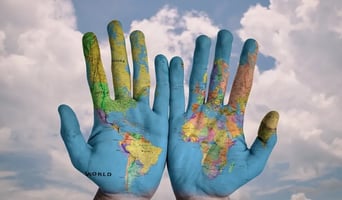One of the main characteristics that distinguishes humans from other animals is our ability to articulate complex ideas through language. But since when do we have records of such a distinction? It is difficult to answer questions about such distant times, and there are still important debates among linguists and historians about the origin and development of the languages we know today.
In this article, we will explore the main theories underlying these debates, discover which are the oldest languages still spoken and learn about the languages for which we have the earliest evidence.
Get ready to dive into the fascinating history of languages!
Debates and theories on the world's first language
As mentioned, the concept of "the world's oldest language" has given rise to much debate and speculation over the years. There are different interpretations of the origin of languages, but all of them are hypothetical and lack definitive evidence to be widely accepted by researchers. The most widespread theory proposes the proto-sapiens language as the first language spoken by humankind and from which all other languages were derived. Although with some controversy, attempts have been made to reconstruct parts of this language, looking for similarities between words by sound and meaning in different languages around the world. Other hypotheses propose different options, such as multiple origins in different locations, facilitated by a genetic predisposition for language.
Oldest languages still spoken
There are several leading contenders for the title of world's oldest language. These include:
Sanskrit
Although not widely used as a mother tongue for over 3,500 years, it continues to be taught and used in certain religious and academic contexts as it is a liturgical and ceremonial language in Hinduism, Buddhism and Jainism.
Greek
With a documented history of over 3,400 years, Modern Greek is a direct descendant of Ancient Greek. It is spoken mainly in Greece and Cyprus, with approximately 13 million native speakers.
Hebrew
Dating back over 3,000 years, Biblical Hebrew and Modern Hebrew are significantly different, but related. Hebrew was revived as a spoken language in the 19th century and is now the official language of Israel, with about 9 million speakers.
Aramaic
It was the lingua franca of the Middle East more than 3,000 years ago. Although its use has declined significantly, it is still spoken in small communities in various parts of the Middle East, with an estimated few thousand speakers.
Chinese
With a written history of more than 3,000 years, the evolved form of ancient Chinese, specifically Mandarin, is the most widely spoken mother tongue in the world, with more than one billion speakers.
Tamil
One of the classical languages of the world, with a history going back more than 2,500 years. It is spoken mainly in the Indian state of Tamil Nadu, as well as in Sri Lanka, Singapore and Malaysia. It has about 70 million native speakers.
Earliest recorded languages
Apart from those mentioned above, there are also other languages of which we have evidence earlier in human history. These languages provide a fascinating insight into the beginnings of human communication. Some of these languages include:
Sumerian
Sumerian was spoken in ancient Mesopotamia and is considered one of the earliest writing systems in history, the cuneiform script, dating back more than 5,000 years. It has survived to today thanks to the clay tablets used for writing.
Ancient Egyptian
This language has left a remarkable mark on the history of mankind. It was spoken by the inhabitants of ancient Egypt from around 3,200 BC and is known for the hieroglyphs they used to record their beliefs, culture and historical events on murals and papyrus.
Elamite
This language with the cuneiform script was spoken in what is now southwestern Iran. Written records in Elamite appear from about 2,600 BC and are believed to have survived until the 11th century AD.
Hittite
Hittite is one of the earliest recorded Indo-European languages. It was spoken in the Anatolian peninsula, in present-day Turkey, and was written in the cuneiform system. Records in Hittite date back to the 17th century BC.
Ancient Chinese
In the Far East, Chinese writing has one of the longest historical continuities in the world. The earliest known examples of Chinese writing, found in inscriptions on oracle bones and ritual bronzes, date back to 1,200 BC.
Mayan hieroglyphs
Mayan hieroglyphs are one of the oldest writing systems in the Americas, found in what is now Mexico, Guatemala, Belize and parts of Honduras and El Salvador. They were used to record the history and culture of the ancient Maya from approximately 300 BC
These languages provide us with a rich and privileged insight into how our ancestors communicated. Thanks to research on ancient languages, we can appreciate the importance and evolution of human communication throughout history.
If you would like to know more curious facts, such as the most spoken languages in the world or the least spoken languages today, we recommend you explore our blog, where you can also find content related to translation, marketing and the latest technologies.
At iDISC, a translation and IT services agency, we combine language and technology to maximize visibility and boost your company's growth. Contact us to find out how we can help you in your internationalization process.





